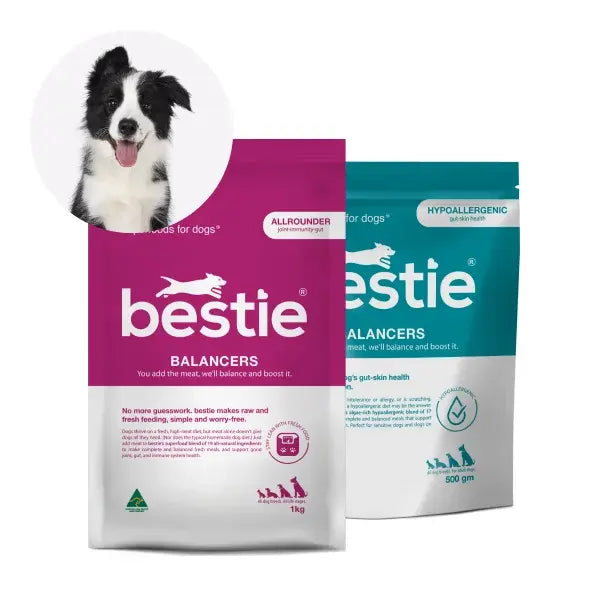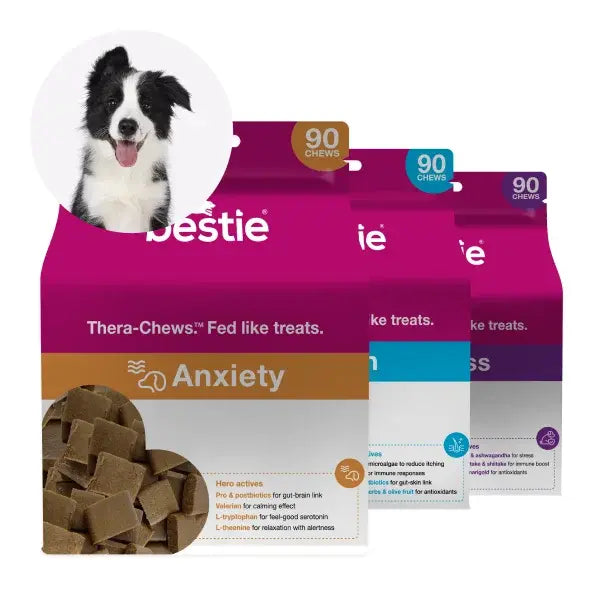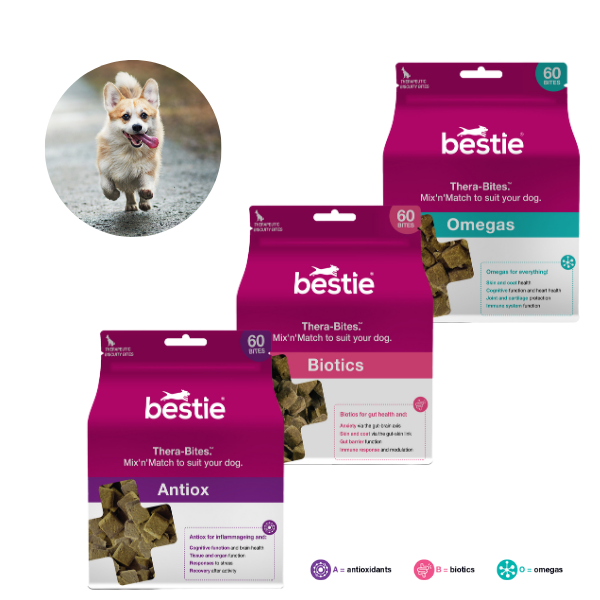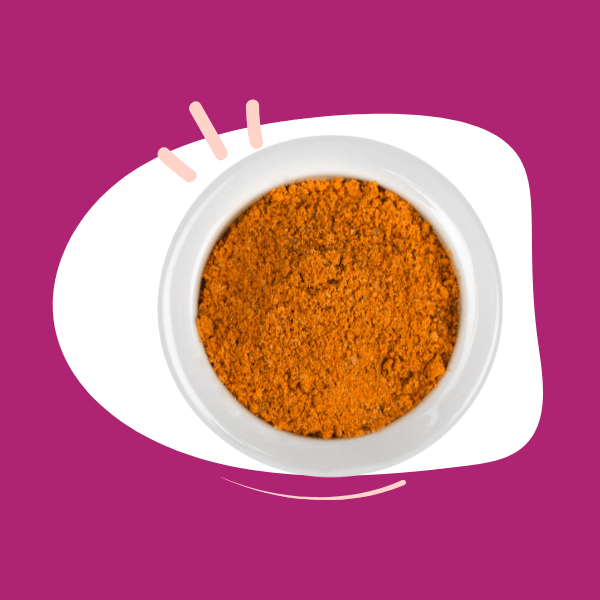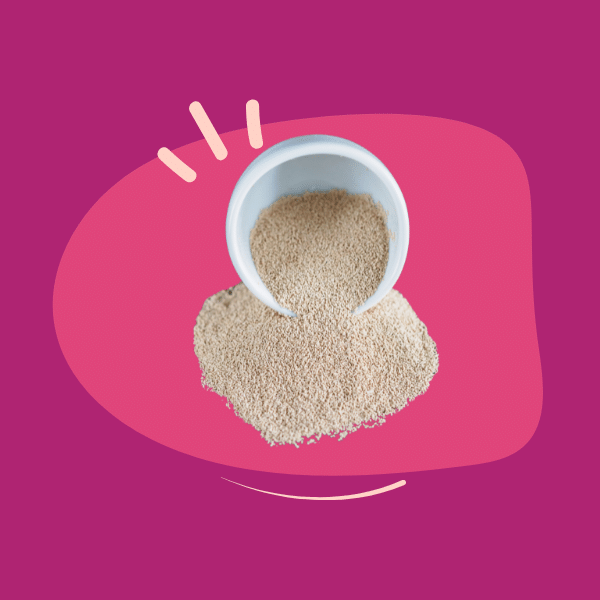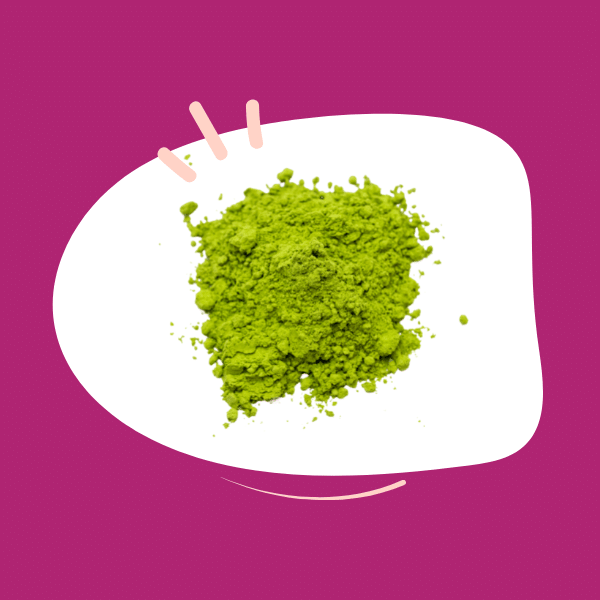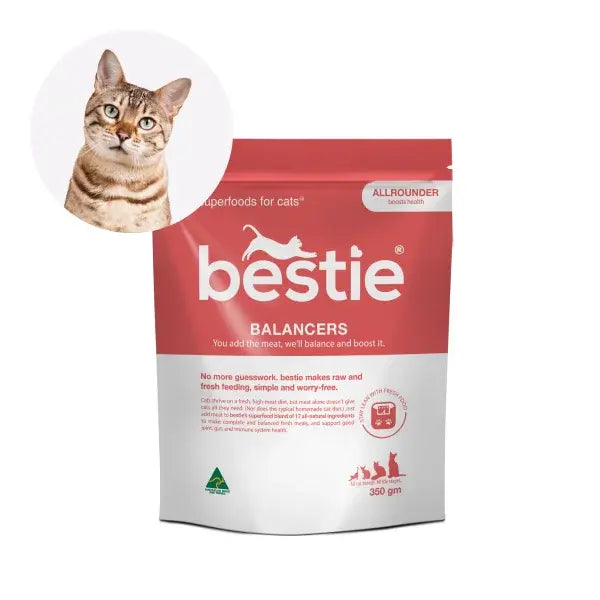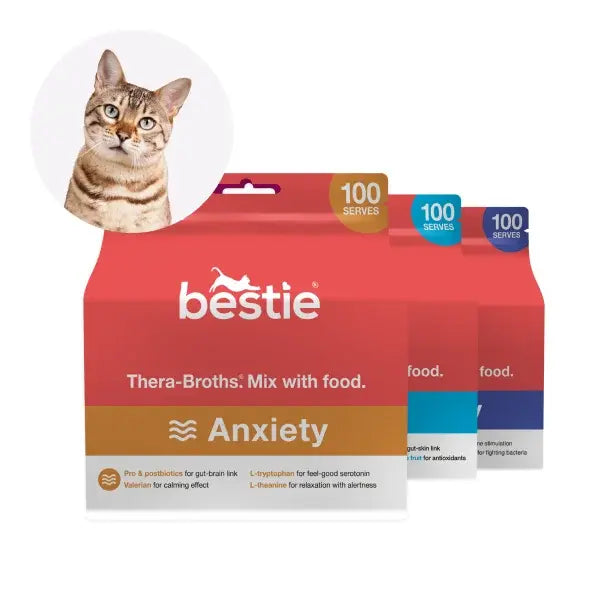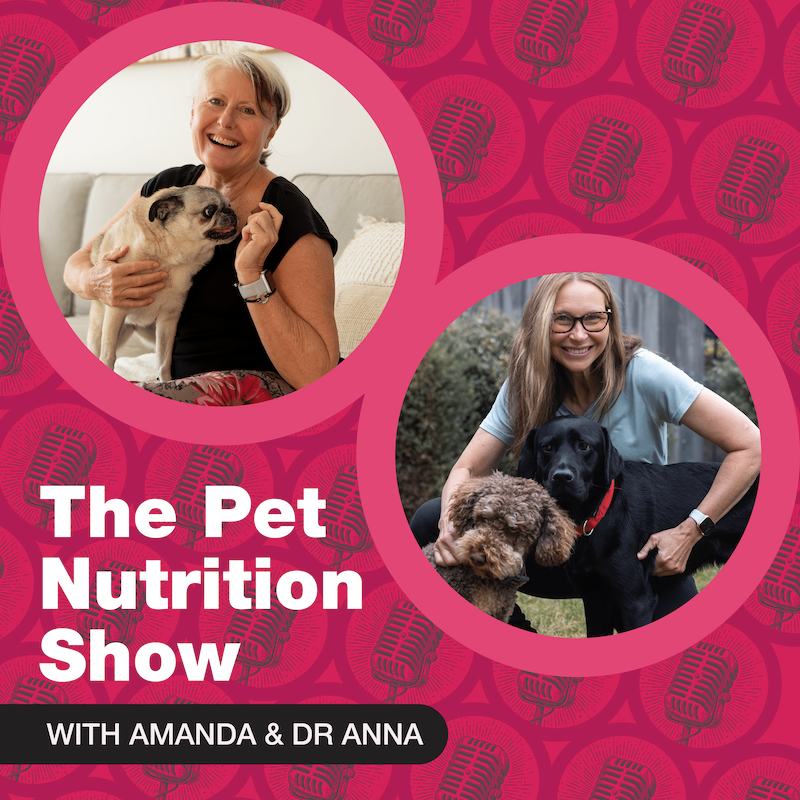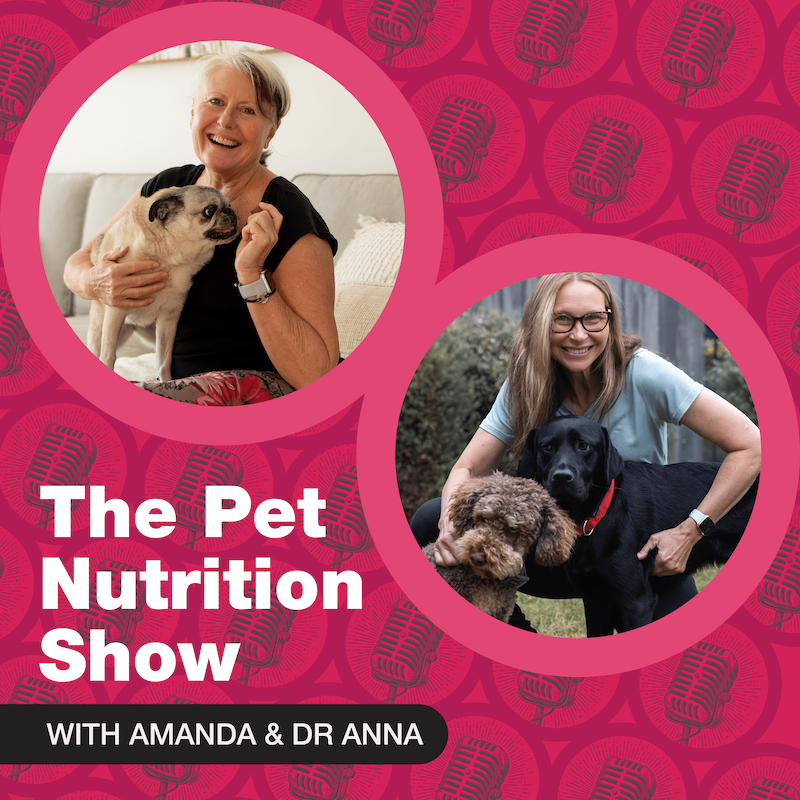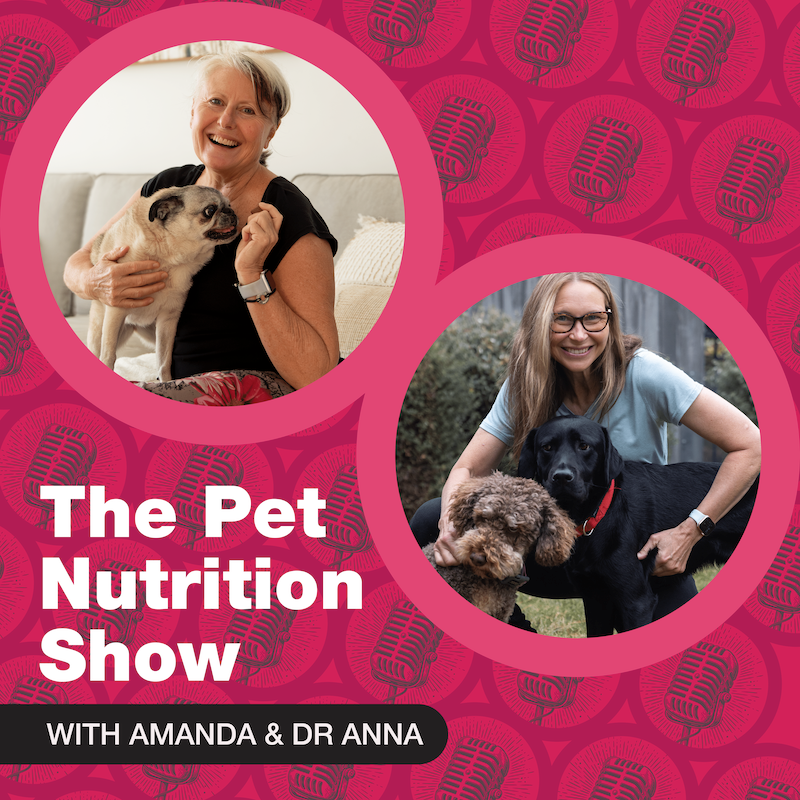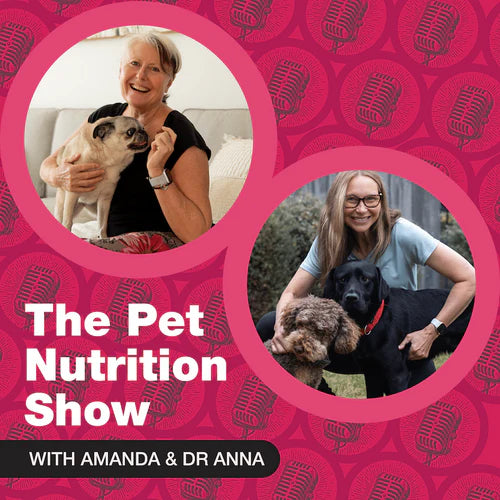In this episode of the Pet Nutrition Show, host Amanda and small animal nutritionist Dr. Anna Sutton discuss the limitations of typical commercial pet diets and the importance of supplementation.
They explain the roles of essential nutrients like Omega-3 fatty acids, antioxidants, prebiotics, probiotics, and postbiotics in promoting pet health. They delve into how these supplements can address specific needs related to joint health, gut health, cognitive function, and overall anti-inflammatory benefits. This episode also highlights Bestie's new range of Thera-Bites, formulated to bridge the nutritional gaps in pet diets.
00:00 Introduction to the Pet Nutrition Show
00:39 Why Supplement Premium Dog Food?
05:28 Understanding Antioxidants for Dogs
12:43 The Role of Omega-3 and Omega-6 Fatty Acids
22:36 Gut Health and Biotics
30:02 Conclusion and Product Launch
Have a listen to the show, but if you’re more of a reader, here's the transcript:
(Note that this transcript has not been edited.)
[00:00:06] AMANDA: Welcome to the Pet Nutrition Show. I'm here with small animal nutritionist, Dr. Anna Sutton, and we are talking about a gap that exists in commercial typical diets or typical commercial diets is probably a better way to put that, which has also given rise to a new range that we are launching at bestie.
[00:00:30] AMANDA: But first, Anna, welcome.
[00:00:33] ANNA: Hello, and Amanda, how are you?
[00:00:36] AMANDA: Very well thank you and very excited about the new range. So lemme ask you first of all, if people are buying a premium dog food, let's just say a kibble to start with. So a premium kibble, why do they need to add anything else?
[00:00:51] ANNA: That's a really good question. I get asked about it quite a lot actually. And the key thing is, whilst actually all commercial dog foods are, or [00:01:00] should be formulated to meet either AAFCO nutrient or the FEDIAF nutrient profiles, depending where you are in the world, that it's important really to understand what it actually means.
[00:01:11] ANNA: And these standards are not necessarily. Designed to promote optimal health across all life stages, breeds or health conditions. They're there to set minimum set, the minimum nutrient standards or the minimum nutrient levels required to avoid deficiency in ill health due to deficiency. So that's a key difference there.
[00:01:32] ANNA: There's a few reasons why then supplementation is beneficial and can sometimes really be even necessary depending on what sort of diet you buy. So first of all, as I said, AAFCO'S minimum, not optimum. So if you've got a dog or a cat for that matter, is, different health needs, for example, there might be a little bit getting on a little bit, a bit like me sometimes actually Amanda might have some joint issues, might have some gut issues or chronic disease and that's where supplements [00:02:00] can come in particularly things that can bega threes and antioxidants.
[00:02:03] ANNA: The other thing is some of the nutrients that are really beneficial to health just aren't actually included in the AAFCO profile or the FEDIAF profile, or if they're there, they're not actually. In enough, in sufficient amount. Gosh, my English is going there. So good example. A good example of that is Omega-3, actually it's in the omega, it's in the AAFCO and FEDIAF nutrients, so EPA and DHA.
[00:02:30] ANNA: The long chain Omega-3 that will talk about sum, but it's in there at a tiny amount. And not really enough to get a real benefit. And it's the same for things like the Omega six free ratio that we'll talk about, I'm sure later, in the AAFCO guidelines and say anything under a 30 to one is good, whereas we know that actually we should probably be aiming for a five to one.
[00:02:54] ANNA: So that's a key point with nutrient inclusion. And of course,
[00:02:58] AMANDA: Let me just interrupt there [00:03:00] because that we just perhaps skipped over one thing and that is that so there are some things like, antioxidants for argument's sake that are not necessarily prescribed in the AAFCO and FEDIAF profile. And by the way, AAFCO is the American standard and FEDIAF is the European standard, and they're similar, right?
[00:03:20] ANNA: Yep, that's absolutely right. They're just Africa for the us FEDIAF for the Europe. And FA and PS are probably a little bit more stringent than AAFCO. Yes, they're both actually based on the underlying NRC National Research Council work from 2006. Mind. But you're dead, right? Antibi antibiotics.
[00:03:39] ANNA: Antioxidants are not in AAFCO or FEDIAF Neither are things like the cosman and chondroitin. Neither are things like pro and prebiotics, which we know are really beneficial.
[00:03:51] AMANDA: And then is, and we are gonna talk about each of these in some detail, but there's also the contribution that [00:04:00] processing makes, particularly processing at high temperatures for things like dry dog food, kibble. That tends to destroy some of those nutrients that might also have antioxidant activity.
[00:04:12] ANNA: Yeah, that's right. Like certain antioxidants are included in the profile. So an example would be vitamin E, for example, and vitamin A are good examples but other antioxidants such as the polyphenols, which you know, have benefits or other things, the cruin eyes for G Lutein for example. They're not included in the profiles and you're dead.
[00:04:32] ANNA: The visa heat sensitive nutrients. And so they're essentially, significantly damaged through processing, whether that be extrusion for a dry kibble or retort for a wet, for a retorted wet product. And the other thing we have is a practical limitation, for example, because these nutrients destroyed fire heat, sometimes we can't.
[00:04:59] ANNA: We can't [00:05:00] put them, for example, in the front end of the extruder, we might put them on the outside of the kibble, but then we run the risk of, in the case of, for example, things like fish oil, oxidizing the kibble and make it nasty to taste. So not very nice to eat for the animal. So there are quite a lot
[00:05:17] AMANDA: because they can't go in, as you say at the front end, they might be sprayed. This is one of those ingredients that might be sprayed onto the surface, but then it oxidizes as you say let's. Actually stay on this antioxidant theme for a moment and talk in more detail about why antioxidants might be helpful to a dog.
[00:05:37] AMANDA: I like to use the analogy that we're all rusting a little bit because we are building up oxidative stress but what is really happening inside the body?
[00:05:48] ANNA: Yeah, that's a great analogy. I'm definitely rusting. I need a bit of WD 40, I reckon, especially in the morning. Anyway. Yes. Rusting from the inside. It's a good term. And it's really a [00:06:00] process that's referring to oxidative stress and. In simple terms, what this is the imbalance between free radicals, which are highly real reactive molecules and the body's natural antioxidant defense systems.
[00:06:18] ANNA: The problem is these three radicals, which these highly react reactive sort of species, molecular species, go on to damage things like cells, proteins, DNA, and lipids. If they're not if you like neutralized quickly enough, and over time, it's that damage that contributes to inflammation. Aging and disease.
[00:06:39] ANNA: So it's a little bit like microscopic wear and tear, if you like. And that's actually where that term inflammaging has come from, which is just a wonderful word
[00:06:49] AMANDA: It is. So that's then potentially building up in, in the brain in joints, in other organs. [00:07:00] Is that what's happening?
[00:07:02] ANNA: That's exactly right. So just to go back a step in terms these free radicals your body produces them naturally, so you produce them when you make energy from the mitochondria, and these are called reactive oxygen species. And then. You've got others, other free radicals that are produced by immune cells and neurons in the brain, for example, and blood vessels.
[00:07:25] ANNA: And these are called reactive nitrogen species or res. And then you've got these external sources like pollution, toxins, processed foods stress ages from say, retorted products. When you get this. This combination of internal and external. If you like oxidative stress outweighing your internal mechanisms to counter it, that's when the oxidative stress kicks up.
[00:07:51] ANNA: And that's exactly what can impact cognitive function. It can impact joint health, for example and all [00:08:00] sorts of things.
[00:08:03] AMANDA: And when dogs well. I had understood that, for instance, dogs, young dogs can synthesize their own vitamin C, which is an antioxidant,
[00:08:16] ANNA: Yep.
[00:08:17] AMANDA: but as they age, and for instance, if they're sick or stressed, then their ability to do that is decreasing, right?
[00:08:25] ANNA: Yep, that's right. That's right. And one of the other interesting things is to see as dog ages and oxidative stress naturally increases. You also get this immune immunosenescence, which is again this sort of aging immune response where the immune system actually becomes less responsive and more inflammatory so it then compounds itself.
[00:08:46] ANNA: So you make less antioxidants for yourself and your immune system's not doing much. So everything. Comes together and contributes.
[00:08:56] AMANDA: So if I and this could apply to me [00:09:00] if I had a lot of antioxidants, does that mean I'm not gonna be aging?
[00:09:03] AMANDA: Is aging inevitable?
[00:09:05] ANNA: oh, look, unfortunately aging is. Inevitable. And I'm very sad to say that but the rate and severity of age related decline is absolutely influenced by lifestyle diet, and your antioxidant status. And that's the same for dogs and the same for humans. And there's a ton of work done in the human space on that.
[00:09:28] ANNA: So where they've looked at, all the the centurion. Live obviously past a hundred if they're centurions living in all these wonderful, actually look absolute beautiful Greek islands with what looks to have lots of red wine and healthy vegetables. But anyway so no, it's whilst aging, we can't control, we can absolutely influence the rate.
[00:09:49] ANNA: And the severity. And so not every dog, for example, is destined to develop cognitive decline or arthritis or what have you. And if we, [00:10:00] pay attention to including things like antioxidants, amiga neural stimulus exercise, then we can delay, reduce, or sometimes even prevent some of these conditions occurring, or at least slow them.
[00:10:17] AMANDA: And so then an antioxidant rich diet could be really helpful what you and me, but also to our dogs.
[00:10:24] ANNA: Yeah, absolutely. Absolutely. And also interestingly, at any time of life, and, the, it is never really too late to start supporting antioxidants to use utilizing antioxidants because you're antioxidants. Needs change through life as we've touched on. So oxidative stress essentially starts at day one.
[00:10:47] ANNA: And then as you move through life there, there are different stresses at different times. So for example, rapid growth in puppy hood or separation, where you're going for weaning going into [00:11:00] active midlife when your dogs are running around like crazy and booing finally onto senior. The senior stages of life where you know that oxidative damage is starting to build up so that absolutely there's a benefit for antioxidants at all stages of life,
[00:11:18] AMANDA: And finally, does it matter what kind of antioxidant you give them? Is any antioxidant the same as any other antioxidant?
[00:11:25] ANNA: That's a really interesting subject. And the answer's actually no, because different antioxidants do different things. So all antioxidants work essentially by stabilizing those free radicals. And what they do is they quench 'em before they can cause damage. And, to try and if you can try and picture these.
[00:11:46] ANNA: These nasty little free radicals, the oxidated damage, the RROS and the RNs. They try and if you like, steal electrons around the surrounding cells. And what the antioxidants do is come in and, give them some electrons in a [00:12:00] controlled way and therefore stop that or slow that chain reaction.
[00:12:04] ANNA: But, so they all work like that, but they do slightly different jobs. For example, vitamin E helps protect cell membranes. Vitamin C tends to work in the kind of watery areas like blood and plasma. It's a water-soluble antiox. Glutathione, for example is one of the antioxidants produced inside the cells.
[00:12:24] ANNA: And then polyphenols and carotinoids have quite unique anti-inflammatory and gene regulating effects. So the point is that we really need all of them and they tend to work synergistically. Meaning that combination is better than any one singular antioxidant alone.
[00:12:43] AMANDA: Now something else that also addresses oxidative stress are omega threes. And they obviously have lots of other benefits, which we're going to talk about more. But how are omega threes different from [00:13:00] omega six, for example?
[00:13:03] ANNA: Yeah, so omega threes and sixes are both polyunsaturated fat, so a polyunsaturated fat is. A fat with lots of double bonds in it. But the what differentiates omega threes is the position of that first double bonds.
[00:13:23] ANNA: It occurs in the third position and Omega-3 and the six position in an omega six and. What that means is it changes the structure of the fatty acids and allows 'em to do different stuff.
[00:13:39] AMANDA: I'm not sure I got all that bond business, but let's talk about the different stuff that they do. So the Omega six does what? And the omega threes do what in comparison?
[00:13:50] ANNA: So in a nutshell, the omega threes are. Anti-inflammatory and the [00:14:00] omega sixes tend to be pro-inflammatory. So that doesn't mean that omega sixes are bad though. It just because you need, absolutely still need your omega sixes. You need them for skin health. You need them to help fight off infection or you need them to help repair wounds.
[00:14:19] ANNA: You need that pro-inflammatory stimulus, but. If you have too much of it, then it's a problem. And what the Omega threes come in and do, and they do lots of other things as well, by the way, is they just balance off the omega sixes in there, in the, in terms of being anti-inflammatory. And in terms of, sorry, go on Omega.
[00:14:41] ANNA: You're good to say
[00:14:42] AMANDA: Yes, because earlier I think you said that yes, we've got, we've definitely got Omega six in the AAFCO and FEDIAF profiles, and we've got omega threes, but at a pretty low level. So is it the case that in the typical commercial [00:15:00] diet there's quite a lot of omega six, but it's not as well balanced by the omega threes?
[00:15:06] ANNA: Yeah, that's exactly that because it's not defined. The ratio is is a large ratio much better than would be optimal. And also the form the EPA and DHA. So the really important omega freeze. Is only mandatory for the growth stage in Africa, for example, not for adults. So people aren't required to put it in.
[00:15:32] ANNA: What is mandatory in all stages from what I can remember, is a LA, so alpha in oleic acid, which is a Omega-3, but it's a very poorly converted omega free. So the efficiency of converting it to EPA is less than 10%.
[00:15:48] AMANDA: And that's the kind of Omega-3 that comes from things like hemp oil and flaxseed oil.
[00:15:53] ANNA: Yeah, flax, particularly flaxseed hemp oils and hemp oil. And hemp oil's got a mixture of omega sixes and a [00:16:00] Omega-3, whereas the flaxseed is just a LA essentially almost just a LA.
[00:16:06] AMANDA: So what's so great then about the EPA and the DHA type of Omega-3 fatty acid. What do they do?
[00:16:15] ANNA: So I could talk for a very long time now on what they do. Amanda,
[00:16:20] AMANDA: We don't want you to talk for a very long time. We want you to talk for a short but informative period of time.
[00:16:28] ANNA: short bit informative. Basically these long chain Omega, so EP, a and d, HA and they are long 'cause you. They're 22 sort of units in length and 20 and 22 respectively. These are what I call, they're in a biological form, so they can do lots of different things. So first of all, they can they're used as precursors to help to create [00:17:00] molecules that directly tackle inflammation.
[00:17:02] ANNA: And you've got two types. You've got the E type of resolving that comes from the EPA, and this is the bit that's important in dealing with inflammation in your joints. And then you've got the D type from DHA. And this is a type that helps with wound healing and gut permeability. They also make these.
[00:17:21] ANNA: They're also precursors to protectins, and this is actually where the neuronal health stuff comes in. So DHA is involved here and these compounds or these molecules are really important in retinal health and Euro protectin. And then you've got another class of RCNs, which is, again, DHA derived, and this is actually quite a special group group of molecules they're made in your macrophages.
[00:17:49] ANNA: And via this sort of 12 LOX enzyme. So different things for different Omega-3. And then in terms of [00:18:00] what they do from a membrane part. Point of view. So they've got two, but say they can be used to make other stuff or they can get directly incorporated into the membranes of actually pretty much every cell in the body, but especially the brain nerve immune heart cells, and.
[00:18:19] ANNA: What they do there is they help keep the membrane nice and fluid and responsive, and that's really important because Canada's cell membranes is where a lot of action happens. Basically, you've got receptors, you've got iron channels and transporters, and if your membranes too rigid, then the doors can't open and close easily and then none of the proteins can function properly and you get.
[00:18:45] ANNA: Slow, weak orach signals, electrical signals, which is to do with those iron channels. And that leads to problems with things like brain functions. So think slow thinking, heart rhythm, arrhythmias and also inflammatory control. [00:19:00] So with VPA and DHA, they can help keep these membranes nice and soft and flexible.
[00:19:09] AMANDA: Sorry Anna. You were talking about the squid of cells. I think to use one of your marvelous words.
[00:19:17] ANNA: Yes, sgi fabulous to, very scientifically accurate of course, but actually it is. It's the omega freeze, as I said, keeps those membranes nice and soft and flexible so that the cells could respond quickly and do what they're supposed to do.
[00:19:35] AMANDA: So really when we say that Omega threes. Actually let me say this another way. So we need omega sixes, but typically diets provide more than enough Omega six.
[00:19:50] ANNA: Yeah.
[00:19:51] AMANDA: Omega threes are in the profile, but the EPA and the DHA, which are the really powerful [00:20:00] ones, are only in the nutritional profile for dogs that are in a growth stage.
[00:20:05] AMANDA: So not for adult dogs. When those EP that EPA and DHA can have marvelous benefits, The E, the DHA and EPA that comes from algae, fish oil, et cetera, is highly bioavailable. Whereas the Omega-3 that comes from flaxseed oil has gotta be converted from its a LA format into an e, p, a or DHA. Yes.
[00:20:39] ANNA: Spot on.
[00:20:40] AMANDA: And it does that at a very low rate.
[00:20:43] AMANDA: So you need a bucket load of flaxseed oil to even start to get anywhere near the kind of result that you're getting with EPA and DHA from fish oil or algae sources. And when we say then that essentially EPA [00:21:00] and DHA help everything, we're not kidding.
[00:21:03] ANNA: No. Pretty much. Pretty much. That's right. And actually, in terms of supplements, it is one of the most evidence-based broad spectrum sort of supplement you. Could possibly choose is a Omega-3 supplement.
[00:21:18] AMANDA: Yeah, but can you overdo it?
[00:21:21] ANNA: You can overdo it. If you went excessively all in, let's say you gave your dog your 10 KG dog, 20 fish oil capsules a day, which would be like horrendous then. Yes, you can overdo it because it's all about a balance. And in that situation you can potentially cause issues where you can slow the rate of clotting down and if you're just giving fish oil, you can bring in a lot of vitamin D, for example.
[00:21:51] ANNA: So yes, you can overdo it, but there's a quite a broad therapeutic range. So the, the active range is typically around [00:22:00] 50 to a hundred mgs. Per kilo body weight, but in certain conditions that might be increased, 200 mgs to 300 mgs per kilo body weight. So you're looking at about three to four grams at the upper level per kg dog, for example.
[00:22:15] AMANDA: And certainly the Omega two that we've developed as part of the terabytes range is focused on EPA and DHA with some other. Fatty acids in there as well, but it's primarily to top up the diet with that really beneficial and bioavailable EPA and DHA. Let's now move to something that isn't in the AAFCO and FEDIAF profiles, but which is also hot on the.
[00:22:45] AMANDA: Or top of mind for a lot of pet owners. And that's something to do with gut health. Now we've loosely calling it biotics, biotics when you look at are, look at them, are increasingly complex because there's the role of prebiotics, then there's [00:23:00] probiotics, then there's postbiotics, then there's symbiotics.
[00:23:03] AMANDA: And the science around gut health is really continuing to evolve at a rapid rate. So let's just start with some basics. People always talk about a healthy gut, and people are really, increasingly focused on that, as I said. But what does a healthy gut really mean?
[00:23:20] ANNA: Well, a healthy gut. Often people think it's just about by di about digestion but actually it's a lot more about a lot more than that. And really when you're talking about healthy gut, you're talking about three main things. First of all. Having a really good, strong gut barrier that basically keeps the bad stuff out.
[00:23:40] AMANDA: That's nutrients in low levels of inflammation and a diverse and balanced microbiota. So that's the right mix of microbes. Preferably living in the right place, doing the right stuff. And if you get all of those three things in place, then the gut [00:24:00] does its job and it supports immunity, brain health, joint function, and skin health and many more things.
[00:24:06] But that sounds pretty simple. So if I just gotta add probiotics to the mix, then I'd get that.
[00:24:11] ANNA: well, not quite, and it's it's probably the way to, I like to think about it a bit like a layer cake, to be honest. So you know, the top layer. Of your digestive system, if you like, is the microbiome. So these are trillions of little living organisms. So this is your pre probiotics bit that you know live quite happily.
[00:24:31] ANNA: They digest food, they produce nutrients to help train the immune system. And when that's all in balance, that's great. Underneath that is a mucosal nail. So this is a slippery barrier that keeps bacteria from outside. Stopping sticking to the gut wall, or heaven forbid actually crossing it and getting inside.
[00:24:52] ANNA: 'cause we don't want that. And then underneath that. Is the epithelial layer. This is the actual gut lining. This is [00:25:00] made of cells that held together by little junctions that form the selectively permeable barrier so they can regulate what goes in and out. And underneath that is the immune tissue and the bloodstream.
[00:25:11] ANNA: When you're thinking about healthy gut, healthy digestive tract, you've gotta think about all of these things. And if you just. Chucked in a load of probiotics, you'd just be adjusting the top layer, and if you didn't take care of everything else, then your pack of cards could fall.
[00:25:27] AMANDA: So how do you take care of everything else then?
[00:25:32] ANNA: So it's essentially looking after all of those free bits. So the first bit, you've got to tackle your microbiota. So here, utilizing a multi-strain probiotic can help utilizing a prebiotic is even more helpful because that's the feed stuff that feeds the microbiota, and that influences which organisms start to proliferate and which don't [00:26:00] because they're food specific.
[00:26:02] ANNA: But at the same time, you've got to look after the mucosal layer. And you can do that again with prebiotics, because prebiotics help they, oh gosh, I'm tripping over my words here.
[00:26:14] AMANDA: Yeah.
[00:26:15] ANNA: Short chain fatty acids produced by the microbiota actually used as an energy source by the cells in the mucosal layers, so that keeps them happy.
[00:26:25] ANNA: And then underneath that for the epithelial layer you can use selective supplements that help regulate the permeability of that, those tight junctions in the epithelial level. So act actually omega threes coming here quite well. And then you can look at using postbiotics or similar to tackle the general immune response, which is.
[00:26:52] ANNA: A little bit little bit like tackling the top layer at the same time, but you're just bypassing actually growing those extra [00:27:00] microbiota.
[00:27:01] AMANDA: So the immune system or the immune response is. Controlled to a very large degree by the gut, isn't it? 70% of our immune cells are actually in the gut.
[00:27:16] ANNA: Yeah, that's absolutely right. And so when the gut goes wrong and that particularly the gut barrier is compromised, then you tend to see chronic inflammation. Food sensitives sensitivities are often linked to gut barrier functions skin issues, digestive problems, and actually even behavioral changes because of the gut brain axis link and it's.
[00:27:39] ANNA: It's a really, it's a whole body effect. And whilst all these layers of the digestive tract, the microbiota through some of the short chain fatty acids they produce, play a role all the way through regulating these different systems.
[00:27:56] AMANDA: Because we talk about the gut skin axis, the [00:28:00] gut brain axis, the gut joint axis, and then, there's the gut and the immune system. So when we are thinking about a healthy gut, then I guess what we are needing is tight junctions, healthy mucosa layer. You can explain that better than me.
[00:28:19] ANNA: you're absolutely right. You want a nice, healthy, diverse population of microbes sitting on top of your, if you like, your gut layers, producing lots of short chain fatty acids, particularly things like butyrate and propionate that are less inflammatory. These then help nourish your mucosal layers your barrier, your first barrier layer, and you want this beautifully intact with no holes.
[00:28:47] ANNA: And then underneath that, you want lovely, strong, regulated, tight junctions between your epithelial cells so you don't get stuff going from outside to inside that you don't want there. And then [00:29:00] you want a nice regulated immune system. So not excessive inflammation which is a response to all these other things being right.
[00:29:11] AMANDA: That's exactly what our biotics Chew does. It's got these awesome prebiotics, a mix of yeast strains, which really help the body's natural defenses and get the immune system to adapt more healthfully. It's also got a mix of two biologically active algae strains, which together tighten that. Tighten those junctions and, strengthen the gut barrier.
[00:29:38] AMANDA: And also, again, help the immune system to respond and adapt. It's got the King of Probio perfectly matched with a prebiotic that works very effectively with that probiotic. And that's what's called a symbiotic, a pro and a prebiotic match together. And then finally we've got postbiotics, which really help with gut balance.
[00:29:59] AMANDA: Oh my [00:30:00] goodness. We've covered all of the bases.
[00:30:02] AMANDA: Thanks for listening to that special edition of the Pet Nutrition Show. This week's episode was sponsored by Bestie, . We are thrilled to be launching this range of terabytes, these yummy, healthy biscuity bites for dogs, antiox, antioxidants, biotics, pre pro and postbiotics. And Omegas, EPA and DHA, fatty acids. See you next time.


